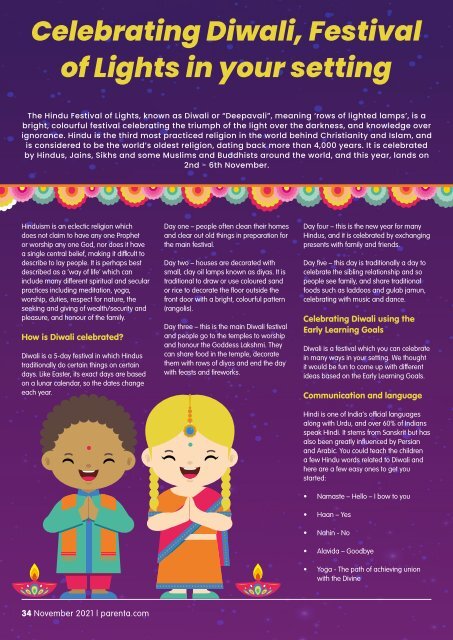November 2021 Parenta Magazine
Create successful ePaper yourself
Turn your PDF publications into a flip-book with our unique Google optimized e-Paper software.
Celebrating Diwali, Festival<br />
of Lights in your setting<br />
The Hindu Festival of Lights, known as Diwali or “Deepavali”, meaning ‘rows of lighted lamps’, is a<br />
bright, colourful festival celebrating the triumph of the light over the darkness, and knowledge over<br />
ignorance. Hindu is the third most practiced religion in the world behind Christianity and Islam, and<br />
is considered to be the world’s oldest religion, dating back more than 4,000 years. It is celebrated<br />
by Hindus, Jains, Sikhs and some Muslims and Buddhists around the world, and this year, lands on<br />
2nd - 6th <strong>November</strong>.<br />
Hinduism is an eclectic religion which<br />
does not claim to have any one Prophet<br />
or worship any one God, nor does it have<br />
a single central belief, making it difficult to<br />
describe to lay people. It is perhaps best<br />
described as a ‘way of life’ which can<br />
include many different spiritual and secular<br />
practices including meditation, yoga,<br />
worship, duties, respect for nature, the<br />
seeking and giving of wealth/security and<br />
pleasure, and honour of the family.<br />
How is Diwali celebrated?<br />
Diwali is a 5-day festival in which Hindus<br />
traditionally do certain things on certain<br />
days. Like Easter, its exact days are based<br />
on a lunar calendar, so the dates change<br />
each year.<br />
Day one – people often clean their homes<br />
and clear out old things in preparation for<br />
the main festival.<br />
Day two – houses are decorated with<br />
small, clay oil lamps known as diyas. It is<br />
traditional to draw or use coloured sand<br />
or rice to decorate the floor outside the<br />
front door with a bright, colourful pattern<br />
(rangolis).<br />
Day three – this is the main Diwali festival<br />
and people go to the temples to worship<br />
and honour the Goddess Lakshmi. They<br />
can share food in the temple, decorate<br />
them with rows of diyas and end the day<br />
with feasts and fireworks.<br />
Day four – this is the new year for many<br />
Hindus, and it is celebrated by exchanging<br />
presents with family and friends.<br />
Day five – this day is traditionally a day to<br />
celebrate the sibling relationship and so<br />
people see family, and share traditional<br />
foods such as laddoos and gulab jamun,<br />
celebrating with music and dance.<br />
Celebrating Diwali using the<br />
Early Learning Goals<br />
Diwali is a festival which you can celebrate<br />
in many ways in your setting. We thought<br />
it would be fun to come up with different<br />
ideas based on the Early Learning Goals.<br />
Communication and language<br />
Hindi is one of India’s official languages<br />
along with Urdu, and over 60% of Indians<br />
speak Hindi. It stems from Sanskrit but has<br />
also been greatly influenced by Persian<br />
and Arabic. You could teach the children<br />
a few Hindu words related to Diwali and<br />
here are a few easy ones to get you<br />
started:<br />
• Namaste – Hello – I bow to you<br />
• Haan – Yes<br />
• Nahin - Noहीं<br />
• Alavida – Goodbye<br />
• Yoga - The path of achieving union<br />
with the Divineयोग<br />
• Diya - The traditional oil lamp used in<br />
Diwali<br />
• Sanskrit – The ancient language used<br />
in Hindu religious texts<br />
Physical development<br />
Teach your children some classical Indian<br />
dance, one form of which is known as<br />
Bharatnatyam. It was originally a temple<br />
dance for women and is often used to<br />
tell religious stories. The movements are<br />
characterised by bent legs and turnedout<br />
feet with symbolic hand and arm<br />
gestures called mudras. You can find some<br />
basic steps at https://www.bbc.co.uk/<br />
newsround/54833725 or you could try<br />
some easy Bollywood dancing.<br />
Personal, social and emotional<br />
development<br />
One of the teachings in Hinduism is about<br />
the connectedness of all things and the<br />
idea that we should live a kind life, which<br />
is in balance with nature to create good<br />
karma. You could explore what kindness/<br />
karma mean in your circle time to see what<br />
your children think being kind to others<br />
means. You could have a ‘kindness day’<br />
where the aim is to be kind to everyone you<br />
see, by a kind word or a kind deed such as<br />
sharing toys, or swapping small gifts.<br />
Literacy<br />
There are books that you can use in<br />
storytime about Diwali that explain what<br />
the festival is about and how people<br />
celebrate it. Twinkl has recently released<br />
“Dipal’s Diwali” which explains how the<br />
protagonist, Dipal, celebrates Diwali with<br />
his family, but there are others such as<br />
“Let’s Celebrate 5 Days of Diwali!” by Ajanta<br />
Chakraborty and “The Diwali Gift” by<br />
Shweta Chopra.<br />
Mathematics<br />
Since there are 5 days in Diwali, you<br />
can base your number work around the<br />
number 5. This is a good number for early<br />
years children because it is the number<br />
of digits on each hand. Make some hand<br />
prints using paint and then label the<br />
numbers 1 to 5 and get the children to<br />
practice writing their numbers. You can<br />
also cut out paper images of diyas and<br />
arrange them in different patterns, or cut<br />
out different sized circles and petal shapes<br />
and get the children to make their own<br />
rangoli patters with the different shapes.<br />
Explore symmetry too by making folding<br />
paintings. Draw a line down the centre of a<br />
piece of paper and get the children to paint<br />
on only one half of the paper. Then fold it<br />
in half so that the image is transferred onto<br />
the opposite half. When you open it up,<br />
you should have a matching, symmetrical<br />
image on both halves of the paper.<br />
Understanding the world<br />
Teach the children some facts about<br />
India – you could show where it is on the<br />
globe, look at some examples of traditional<br />
Indian dress and talk about some of the<br />
differences that exist between the two<br />
countries. Why not consider things like?<br />
• Climate and weather<br />
• Population<br />
• Diet<br />
• National dress<br />
• Music and dance<br />
• Animals<br />
Expressive arts and design<br />
There are many arts and crafts ideas<br />
that you can use to celebrate Diwali such<br />
as making paper lanterns, pictures of<br />
fireworks or rangoli patterns. You could<br />
decorate the floor outside your setting<br />
with chalk rangolis. Remember to make<br />
them bold and colourful to welcome in the<br />
Goddess Lakshmi into your setting. Another<br />
idea is to make some Indian sweet treats<br />
and there are some simple, no-cooking<br />
recipes which are suitable for toddlers.<br />
Diwali is all about light defeating darkness,<br />
so you could encourage your children to<br />
interpret this themselves and give them free<br />
reign over what to draw to show this.<br />
Remember to send us in your images and<br />
stories to hello@parenta.com to let us know<br />
what you get up to. Happy Diwali!<br />
34 <strong>November</strong> <strong>2021</strong> | parenta.com<br />
parenta.com | <strong>November</strong> <strong>2021</strong> 35

















